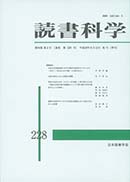Volume 51, Issue 3-4
Displaying 1-8 of 8 articles from this issue
- |<
- <
- 1
- >
- >|
-
2009Volume 51Issue 3-4 Pages cover1-
Published: March 15, 2009
Released on J-STAGE: January 13, 2020
Download PDF (127K) -
2009Volume 51Issue 3-4 Pages TOB1-
Published: March 15, 2009
Released on J-STAGE: January 13, 2020
Download PDF (82K)
Original Articles
-
2009Volume 51Issue 3-4 Pages 85-95
Published: March 15, 2009
Released on J-STAGE: January 13, 2020
Download PDF (458K) -
2009Volume 51Issue 3-4 Pages 96-106
Published: March 15, 2009
Released on J-STAGE: January 13, 2020
Download PDF (430K) -
2009Volume 51Issue 3-4 Pages 107-118
Published: March 15, 2009
Released on J-STAGE: January 13, 2020
Download PDF (400K)
Study Report
-
2009Volume 51Issue 3-4 Pages 119-125
Published: March 15, 2009
Released on J-STAGE: January 13, 2020
Download PDF (304K)
-
2009Volume 51Issue 3-4 Pages Colophon1-
Published: March 15, 2009
Released on J-STAGE: January 13, 2020
Download PDF (226K) -
2009Volume 51Issue 3-4 Pages Regulation-
Published: March 15, 2009
Released on J-STAGE: January 13, 2020
Download PDF (184K)
- |<
- <
- 1
- >
- >|
